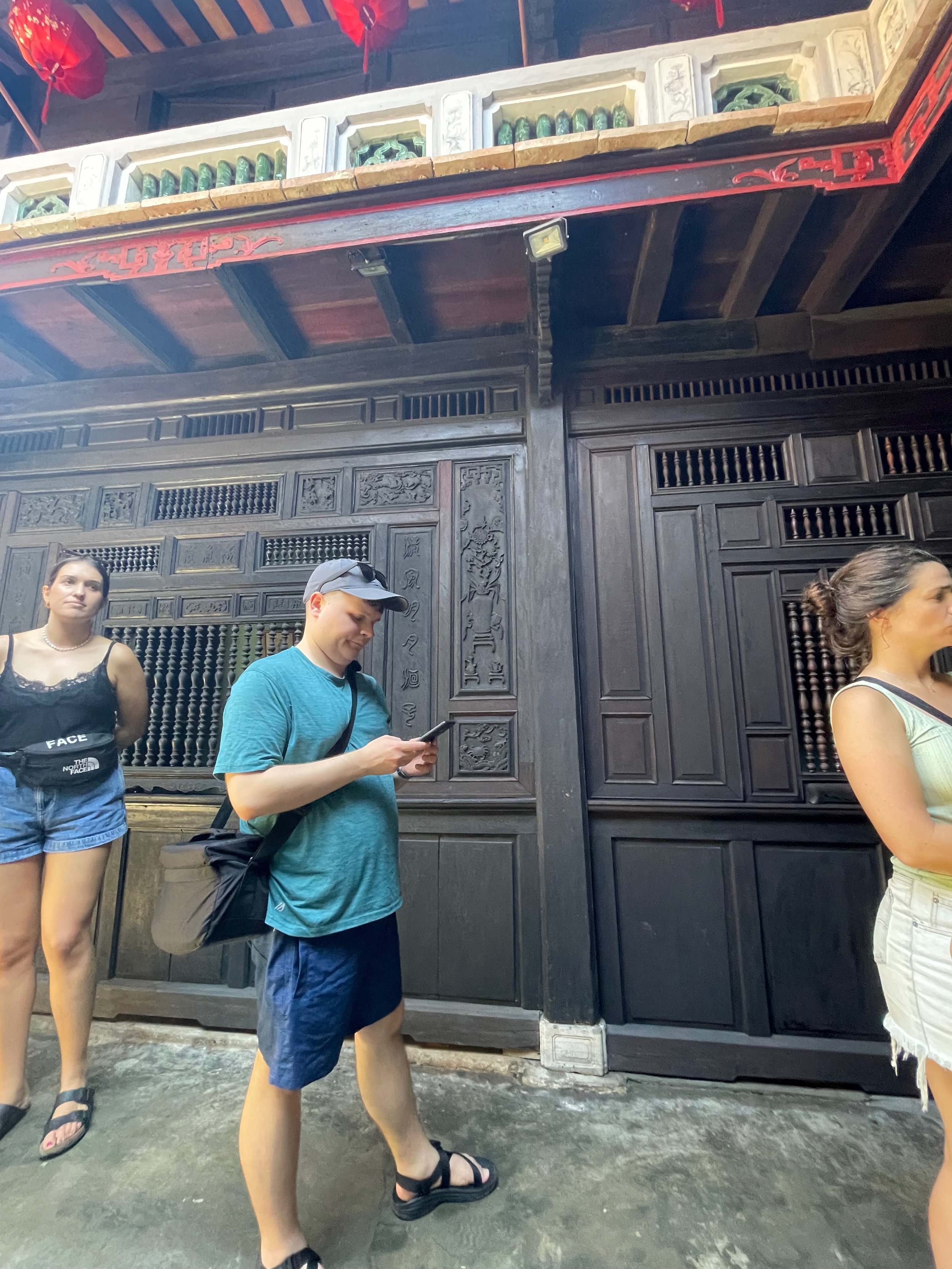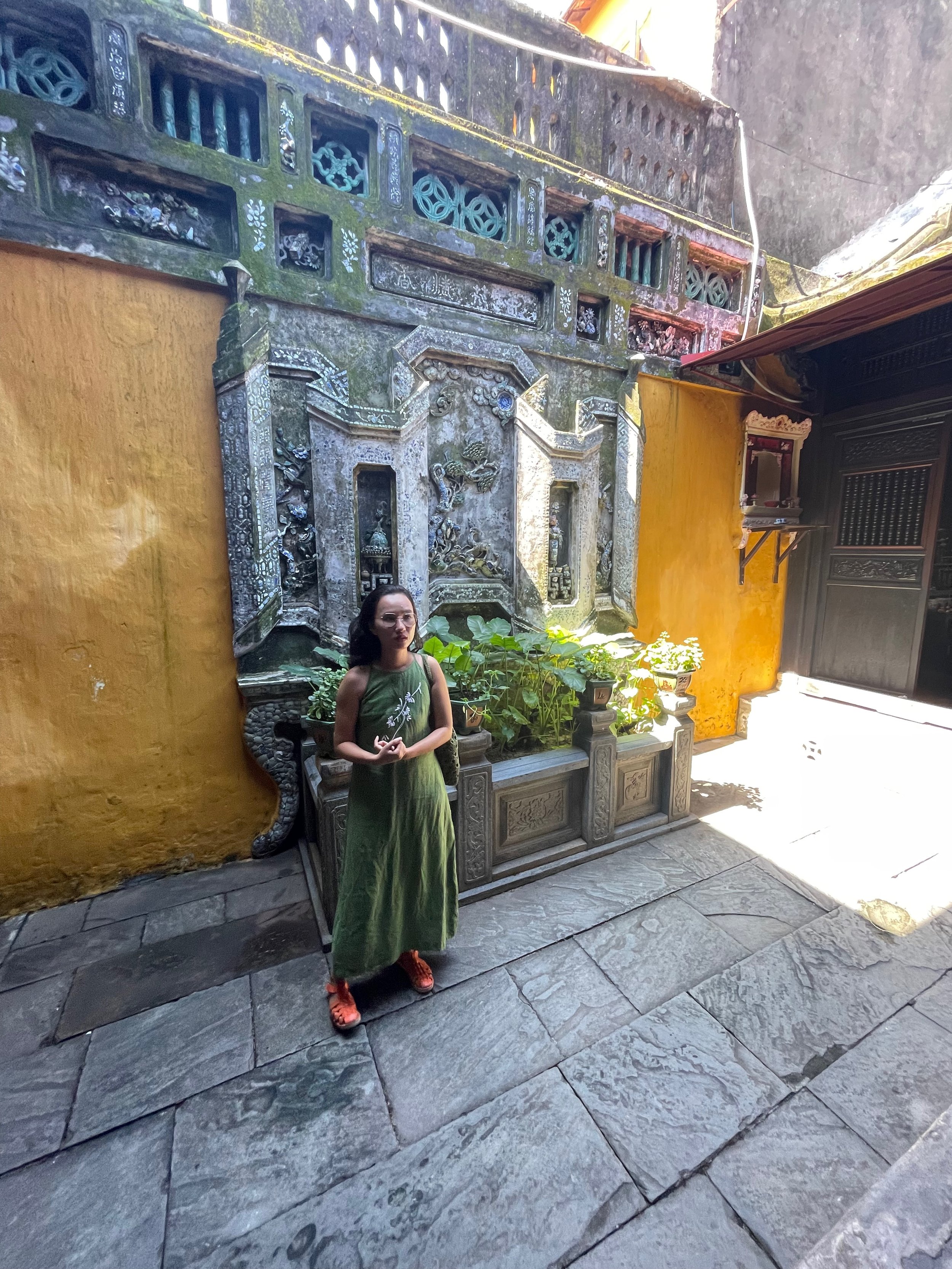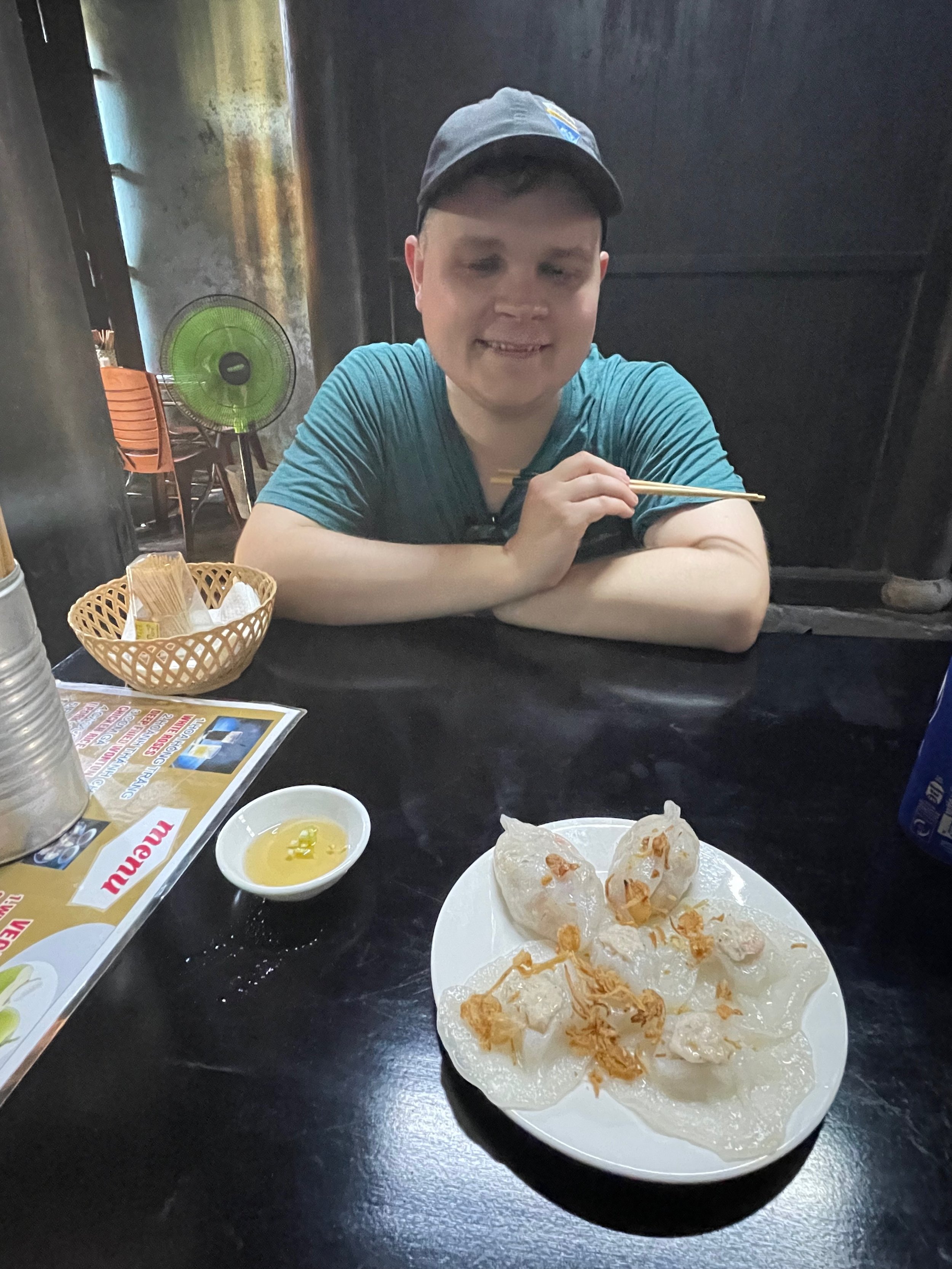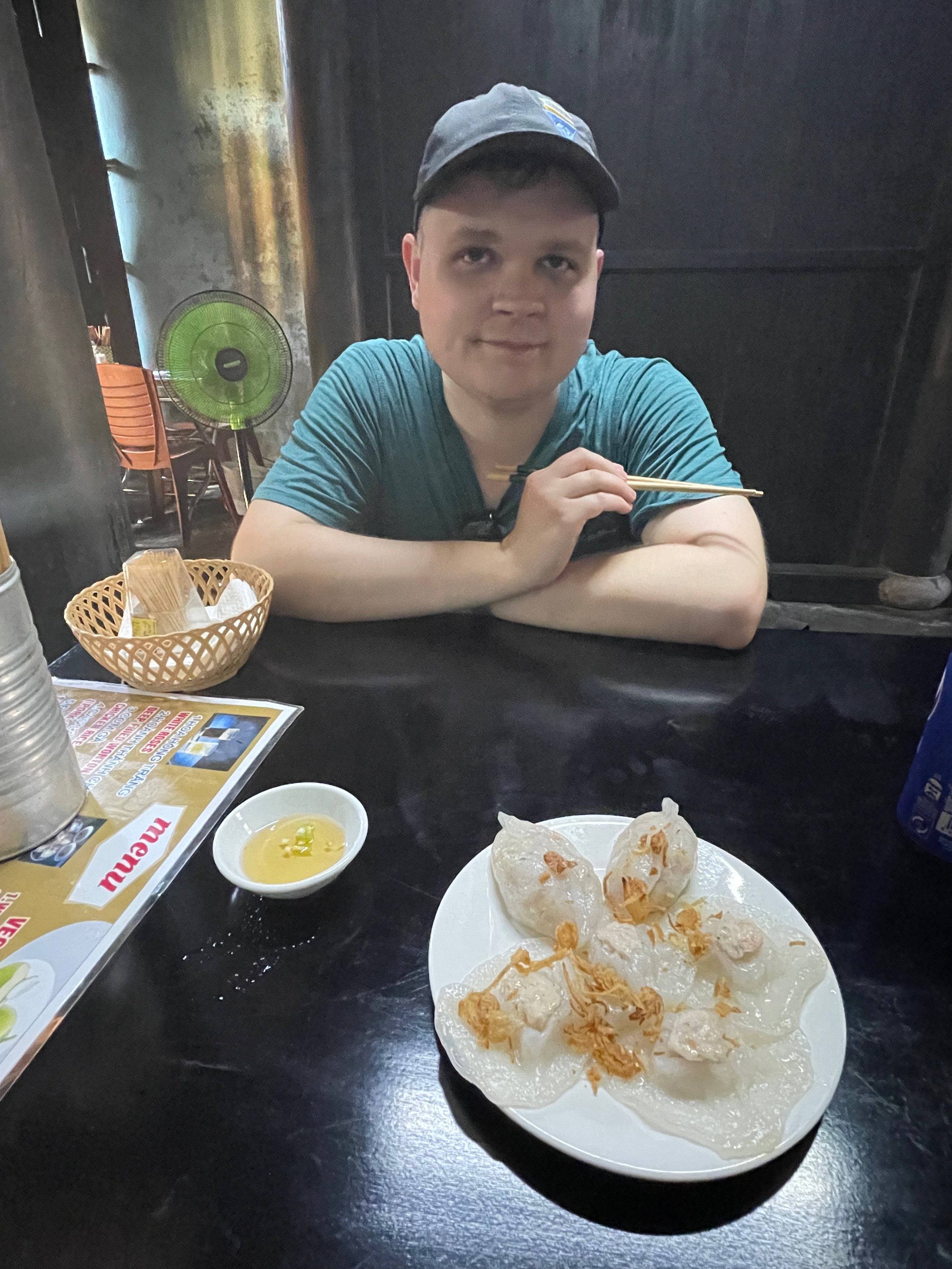Our Last Day in Hội An
By Lauren Gerzina & Justin Hayes
Walking Tour, White Rose Dumplings, and Shipping Stuff
We did it a bit backwards this time.
Normally, we try to take a walking tour when we first arrive to get the lay of the land and a sense of the area. But for whatever reason, we saved this for our last day. We did plenty of exploring of the city during our time here, but we still felt like we quite didn’t understand enough about the history of many of the old buildings and the influence of other cultures like the Chinese and Japanese.
So since we stumbled upon the free GuruWalk tour during our attempt to explore some of the ancient city the day before, we booked it and joined up for our last full day in Hoi An. And it was great!
Our guide, Huyen, gave us a ton of historical and cultural context in a relatively short amount of time. She told us about the First Nations people of Hoi An, the Chăm Pa, and how many of their traditions still live on with the Vietnamese people such as food and architecture. We learned about the “bad wind,” which was the belief that certain winds carried sickness and disease, and how many people still use traditional medicine and house designs to ward off the bad wind.
We also learned about the difference between the Japanese and Chinese quarters of the Old Town. Hoi An was a trading port for the Japanese for decades while many Chinese people migrated to this region around the same time. At that time, Hoi An allowed foreigners to purchase and own property (only Vietnamese people can own land today), and it contributed to the city’s economic prosperity as a hub for trade.
Thus, the buildings and temples in the city contain influences of both Japanese and Chinese culture, with the Old Town separated by the Japanese bridge between the Japanese and Chinese quarters. The Japanese bridge was built by many people, but the Japanese contributed the most to it, so it got the naming rights. Although it’s currently under rennovation, we got to see some remnants of it, including a famous statue of a dog and a monkey, as well as the shrine to the god of the bridge.
Huyen told us that in Vietnamese culture, anyone could become a god and that often after important people in a town or city die, they will be given god status, including a place to give offerings and pray to them for prosperity, luck, etc. Temples could contain any god, but pagodas always contain statues of Buddha.
Speaking of animals, our tour guide also taught us the animal of our birth year – Justin is a snake and Lauren is a goat. Apparently when a snake and a goat are together, it’s a fantastic match and very lucky. Nailed It!
We then walked over to a performance in a small theater where they played Vietnamese music on traditional instruments and excerpts from longer plays/stories, including (and we could be butchering this) one about a woman who uses a magic item (like a flower) to turn from a fox into a human. She marries a man, but then commits adultery and has her magic item stolen and turns back into a fox.
There was also a dance that pays ohmage to the Chăm Pa culture and a story about how young people work and flirt in rice fields. It was very entertaining and nice to sit in the A/C for a little bit to cool off.
Next, we headed to an old Chinese-style house where a family had been living there for over seven generations. They currently are one of only two families in the area that make traditional white rose dumplings and supply them to restaurants around Hoi An. We learned that the houses in Vietnam, like this one, were generally always open to allow both air and people to flow in and out. It also helps to let the water flow through during floods, which this area is prone to get. On one of the walls were markings from various years where major floods had come through the area. Huyen told us that 1999, even though it was a lower flood level, was particularly bad because Vietnam had terrible weather forecasting and that no one expected any flooding on that day and did not prepare. She said the weather forecasting has gotten better but that it still is bad sometimes.
Our last major stop was at the Hoi Quan Phuoc Kien Chinese Assembly Hall. This is the temple that we visit on the previous day, but didn’t really know what we were looking at (see yesterday’s post for more pictures). Essentially, this was built as a meeting place for 17th Century Chinese residents to come and talk about the town’s affairs or just general updates about their families and personal lives. The temple is also dedicated to the worship of Mazu, a Chinese sea goddess that blesses fisherman/sea traders (and now all travelers), and the lady Buddha.
Huyen also told us about a particular shrine in the temple devoted to fertility, where many Vietnamese people come to pray or give offerings when they are trying for a baby or facing infertility issues. She said that Vietnam used to be more conservative and women were shunned (or worse) for getting pregnant before marriage. But now that more women are having fertility issues, many parents and even some older people are happy when women in their family get pregnant (even before marriage) because it means more babies.
We ended our tour at the Hoi An Central Market. Huyen showed the rest of the people in our group where to get the traditional Hoi An dish Cao Lao, but we wanted to try the white rose dumplings at the Chinese house we had visited earlier – why not go to the source, right?
We went back to the house and looked for the ladies making dumplings to request a table. They quickly brought out the white rose dumplings (made from rice flour, not wheat) for us to share and as soon as they were done, the cao lao (the traditional Hoi An noodle dish) came out. Both dishes were so good, and Lauren was especially hungry because this morning’s breakfast was a 5-minute chow down on some pho so we wouldn’t be late to the tour. So we bought another order of dumplings.
After lunch, we walked back to the shoe shop to pick up our custom leather shoes. The shoes weighed a whopping 3 kg – that will be fun to ship. We took a Grab back to the Airbnb and loaded the rest of our souvenirs into bags. After texting our clothing gurus that we were on our way, we walked the approximately five minutes to their shop loaded up with tons of stuff to send home.
When we got to the shop, an adorable tiny woman was there with a big box ready to pack up for us. She was shocked at how much stuff we brought to ship – so we knew this was going to be a fun experience. In all, we packed 2 dresses, 2 suit jackets, 3 pairs of pants, 3 shirts, 2 pairs of shorts, a Starbucks mug, 2 lanterns, 2 pairs of cowboy boots, 1 pair of dress shoes, our lacquer paining, and a tube with 2 Hoi An paintings. And maybe a partridge? No one knows.
In all, it weighed 16kg. This was a very expensive shipment, but we were very glad not to carry it for the next two months of our trip. She could not fit it all in the one large box she brought so the ladies from the shop helped her to load the still opened box onto the back of her motorbike, and she put the lacquered painting on the floor in front of her. She grabbed the flap of the box behind her and zoomed off while we stood there with our mouths agape. We were so surprised that we didn’t manage to get a picture of all our stuff riding off into the sunset.
Justin had been battling either dehydration or clogged ears (or both) all day (with a massive headache) so we came back to the room to chill, drink tons of water, and take a nice nap.
When we woke up, we decided to take it easy and walk to the first restaurant we tried in Hoi An, Morning Glory. We reordered the exact same meal as the first time while listening to live music (a man and woman singing/playing guitar and singing). They played some well-known songs like “Layla”, “Tiny Dancer”, and “Rocket Man”. We grabbed some water from the nearby mini mart, bought some last-minute souvenirs for Justin, and went back to the room to crash for the night.
We are sad that our time in Hoi An is ending, but we are also excited about our upcoming cruise on Ha Long Bay!


















































